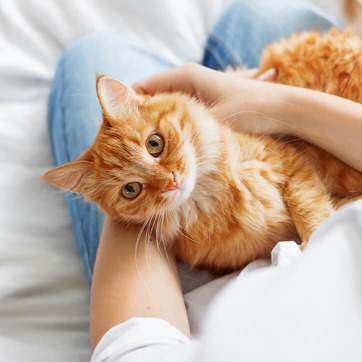Hip joint dysplasia (HD) in the cat
In hip dysplasia, the head of the joint does not lie optimally in the underdeveloped acetabulum. This maldevelopment can have various causes, such as genetic disposition, too rapid growth due to incorrect feeding, persistent physical overload or other environmental influences.
Even before the first symptoms appear - such as a "strange gait" in your cat or problems getting up – a predisposition to HD is recognisable in the X-ray image. Unfortunately, you cannot prevent this development. However, if it is detected in time, conservative treatment may prevent the need for surgery. As with all other joint diseases in your cat, the first thing the vet will want to do with hip dysplasia is to reduce your cat's body weight if he is overweight. Weight control is accompanied by anti-inflammatory painkillers and joint-building substances.
In small animals like the cat, removal of the affected femoral head, which is often already affected by osteoarthritis, can be a good option. This procedure is called femoral head resection. The muscles then form a "pseudo joint". The animal is relieved of the joint pain and can often move again as before the disease.
Alternatively, an artificial joint replacement can provide the affected animal with freedom from pain and movement. Please discuss the individual therapy with your attending physician.
To enable your cat to enjoy exercise and quality of life, you should provide a healthy and balanced diet from an early age. To support the musculoskeletal system and joint processes, special feeds with joint-active, high-dose ingredients such as green-lipped mussel, chondroitin, glucosamine, rosehip powder and omega-3 fatty acids are valuable supplements at any age.

Elbow dysplasia (ED) in the cat
Elbow dysplasia is a collective term for various malformations of the elbow joint. The joint consists of the upper arm, ulna and radius. In ED, the joint surfaces are altered by malformations in such a way that the three bones involved no longer fit together properly. To compensate for the poor fit of the joint surfaces, the organism forms bony spurs over time, which in turn can end in arthrosis.
The causes of elbow dysplasia are the same as those of hip dysplasia: genetic disposition, too rapid growth due to incorrect feeding, prolonged physical overload or other environmental influences. Injuries can also cause ED due to trauma.
If your cat's gait changes and he has problems standing up and lying down, you should have his forehand lameness examined by a veterinarian. An x-ray will provide information. The decision on treatment will then depend on the appearance of the condition, the degree of symptoms and further findings.
For elbow dysplasia, the veterinarian will try to proceed arthroscopically, with only a small opening of the joint. Through arthroscopy, loose cartilage-bone fragments can be removed to give the animal back freedom of pain and movement. In addition to keeping the animal indoors for about 6 weeks afterwards, healing is supported by anti-inflammatory and pain-relieving medication.
To prevent this from happening, please ensure that your cat has a healthy joint diet from an early age. With omega-3 fatty acids, vitamin E, green-lipped mussel, rosehip, chondroitin and glucosamine, there is also a wide range of nutrients that are helpful in supporting the joint metabolism.

